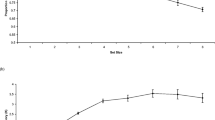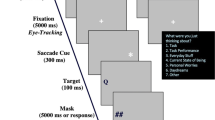Abstract
Perceptual learning is critical in many settings. In the present study, we investigated the role of individual differences in attention effort in perceptual learning by having participants learn to detect rare cryptic figures. We employed both functional near-infrared spectroscopy measures of frontal cortical activity and self-reports of pre-task motivation in order to assess individual differences in attention effort. We also manipulated performance feedback and the amount of background information provided to the participants regarding the task. Twelve men and 28 women participated in the experiment. Performance metrics were indicative of perceptual learning occurring. Overall performance on the task was correlated significantly with pre-task levels of self-reported motivation and the rate of learning was correlated with initial oxygen response in the frontal cortex. The initial spike in frontal oxygen response declined with time on task, perhaps due to shifts towards automaticity. The results suggest perceptual learning is influenced by individual differences in attention effort.





Similar content being viewed by others
References
Altman DG, Bland JM (1994) Statistics notes: diagnostic tests 2: predictive values. BMJ 309:102
De Joux N, Russell PN, Helton WS (2013) A functional near-infrared spectroscopy study of sustained attention to local and global target features. Brain Cogn 81:370–375
Foyer-Lea A, Matthews PM (2004) Changing brain networks for visuomotor control with increased movement automaticity. J Neurosci 92:2405–2412
Helton WS (2007) Skill in expert dogs. J Exp Psychol: Appl 13:171–178
Helton WS, Head J (2012) Earthquakes on the mind: implications of disasters for human performance. Hum Factors 54:189–194
Helton WS, Russell PN (2011) The effects of arousing negative and neutral picture stimuli on target detection in a vigilance task. Hum Factors 53:132–141
Helton WS, Warm JS (2008) Signal salience and the mindlessness theory of vigilance. Acta Psychol 129:18–25
Helton WS, Hollander TD, Tripp LD, Parsons K, Warm JS, Matthews G, Dember WN (2007) Cerebral hemodynamics and vigilance performance. J Clin Exp Neuropsychol 29:545–552
Helton WS, Warm JS, Tripp LD, Matthews G, Parasuraman R, Hancock PA (2010) Cerebral lateralization of vigilance: a function of task difficulty. Neuropsychologia 48:1683–1688
Helton WS, Head J, Kemp S (2011) Natural disaster induced cognitive disruption: impacts on action slips. Conscious Cogn 20:1732–1737
Hill NM, Schneider W (2006) Brain changes in the development of expertise: neuroanatomical and neurophysiological evidence about skill-based adaptations. The Cambridge handbook of expertise and expert performance, pp 653–682
Keppel G, Zedeck S (2001) Data analysis for research designs. WH Freeman & Co, New York
Kluger AN, DeNisi A (1996) The effects of feedback interventions on performance: a historical review, a meta-analysis, and a preliminary feedback intervention theory. Psychol Bull 119:254
Langner R, Eickhoff SB (2012) Sustaining attention to simple tasks: a meta-analytic review of the neural mechanisms of vigilant attention. Psychol Bull [online advance publication] doi:10.1037/a0030694
Langner R, Willmes K, Chatterjee A, Eickhoff SB, Sturm W (2010) Energetic effects of stimulus intensity on prolonged simple reaction time performance. Psychol Res 74:499–512
Leavitt J (1979) Cognitive demands of skating and stick handling in ice hockey. Can J Appl Sport Sci 4:46–55
Matthews G, Joyner L, Gilliland K, Huggins J, Falconer S (1999) Validation of a comprehensive stress state questionnaire: towards a state big three? In: Merville I, Deary IJ, DeFruyt F, Ostendorf F (eds) Personality psychology in Europe. Tilburg University Press, Tilburg, pp 335–350
Matthews G, Campbell SE, Falconer S, Joyner LA, Huggins J, Gilliand K (2002) Fundamental dimensions of subjective state in performance settings: task engagement, distress, and worry. Emot 2:315–340
Matthews G, Warm JS, Reinerman-Jones LE, Langheim LK, Washburn DA, Tripp L (2010) Task engagement, cerebral blood flow velocity, and diagnostic monitoring for sustained attention. J Exp Psychol Appl 16:187–203
Mukai I, Kim D, Fukunaga M, Japee S, Marrett S, Ungerleider LG (2007) Activations in visual and attention-related areas predict and correlate with the degree of perceptual learning. J Neurosci 27:11401–11411
Mukai I, Kandy B, Kesavabhotla K, Ungerleider LG (2011) Exogenous and endogenous attention during perceptual learning differentially affect post-training target thresholds. J Vis 11:1–15
Ossowski U, Malinen S, Helton WS (2011) The effects of emotional stimuli on target detection: indirect and direct resource costs. Conscious Cogn 20:1649–1658
Ryan RM, Rigby CS, Przybylski AK (2006) Motivation pull of video games: a self-determination theory approach. Mot Emot 30:347–365
Shaw TH, Warm JS, Finomore V, Tripp L, Matthews G, Weiler E, Parasuraman R (2009) Effects of sensory modality on cerebral blood flow velocity during vigilance. Neurosci Lett 461:207–211
Shaw TH, Finomore V, Warm JS, Matthews G (2012) Effects of regular and irregular event schedules on cerebral hemovelocity during a sustained attention task. J Clin Exp Neuropsychol 34:57–66
Stevenson H, Russell PN, Helton WS (2011) Search asymmetry, sustained attention, and response inhibition. Brain Cogn 77:215–222
Szalma JL, Hancock PA, Warm JS, Dember WN, Parsons KS (2006) Training for vigilance: using predictive power to evaluate feedback effectiveness. Hum Factors 48:682–692
Toronov V, Webb A, Choi JH, Wolf M, Michalos A, Gratton E et al (2001) Investigation of human brain hemodynamics by simultaneous near-infrared spectroscopy and functional magnetic resonance imaging. Med Phys 28:521–527
Watanabe T, Nanez JE, Sasaki Y (2001) Perceptual learning without perception. Nature 413:844–848
Watanabe T, Nanez JE, Koyama S, Mukai I, Liederman J, Sasaki Y (2002) Greater plasticity in lower-level than higher-level visual motion processing in a passive perceptual learning task. Nature Neurosci 5:1003–1009
Wiggins MW, O’Hare D (2003) Expert and novice pilot perceptions of static in-flight images of weather. Int J Aviat Psychol 13:173–187
Wilson KM, Helton WS, Wiggins MW (2013) Cognitive engineering. WIRES: Cognit Sci 4:17–31
Yoshitani K, Kawaguchi M, Tatsumi K, Kitaguchi K, Furuya H (2002) A comparison of the INVOS 4100 and the NIRO 300 near-infrared spectrophotometers. Anthesia Analg 94:586–590
Author information
Authors and Affiliations
Corresponding author
Rights and permissions
About this article
Cite this article
Ong, M., Russell, P.N. & Helton, W.S. Frontal cerebral oxygen response as an indicator of initial attention effort during perceptual learning. Exp Brain Res 229, 571–578 (2013). https://doi.org/10.1007/s00221-013-3619-9
Received:
Accepted:
Published:
Issue Date:
DOI: https://doi.org/10.1007/s00221-013-3619-9




